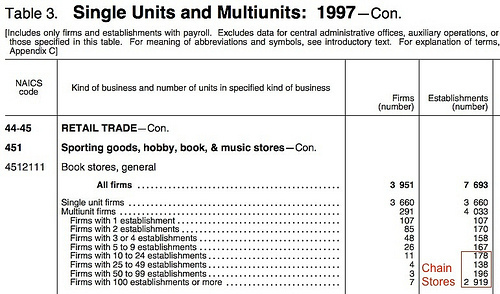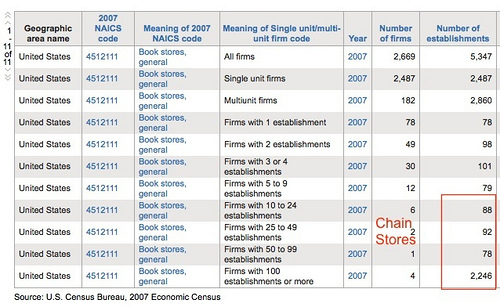The State of Indies in the States
Over the past few months, I've spent perhaps a bit too much of my free time researching the status of independent bookstores in the United States. Article after article mentioned how we have to "support our local indie" or suffer the consequences. So I wondered just how close to death America's independent bookstores really were, then Googled it. Nothing. No one could tell me. Just the simple question "How many independent bookstores are in the U.S.?" brought back conflicting totals. The American Booksellers Association said membership was up, but not every indie joins. Wikipedia was practically useless and sketchy. I kept digging.
I took to the U.S. Economic Census data and found totals for 1997 - 2007. The 2007 numbers were very, very scary. I hoped things had turned around. It just so happens that the census from 2012 has not been compiled and released yet, so I had to take to Google again. Lucky for me Publishers Weekly collected information on the nation's bookstores in 2013. Unfortunately, the methodology and recording had some issues (see note below), but I was able to get a better tally and the results were unimaginable.
I present to you a short history of what has really happened to physical bookstores since Amazon and ebooks came to be.
Please note: I have listed all companies with 10 or more stores as "the chains." I understand that some indies may have 10 or more, but this would only make the indie numbers that more impressive. And all college bookstores, religious bookstores, and big-box stores like Costco, Walmart, Target, etc. are not included these totals.
In 1995, Amazon announced their plan to sell books online. "What do you mean online? Like at the bank?" the people asked. Two years went by...
Then Amazon hit its stride...
Amazon became the place for books!
It was a dark period for indie stores. The lowest numbers ever seen.
The most recent number of indies seems so high it feels unbelievable. 1,200 stores opened (or re-opened) in six years? How can this be? Especially since ebooks started to gather steam in 2010. Keep in mind that ebooks really took off when B&N, Kobo, and Amazon released their reading apps for smart phones and tablets. You no longer needed to carry around a dedicated e-reader, just your phone. That very year, Borders and B. Dalton Booksellers were closing stores like mad. All before ebooks really caught on.
So after six years of the Kindle, and two full years of ebooks being more accessible on apps, where is the effect? Do ebooks really need another two or three years to make a dent? The iTunes store debuted in 2003, and by 2006 most stores specializing in CDs were packing it in. But books are different.
Allow me this short digression. No one goes on iBooks and downloads ten books at a time. Nor do they read ten books in a week. Books are slow entertainment. Even audiobooks take anywhere from 5 to 20 hours to consume. A person busy reading is not busy buying. You can probably entice someone to buy more books if you get the price low enough, but eventually people will notice their "to-be-read" pile is out of control. Maybe. Ebooks are out of sight and out of mind. The only indication you'd have of a crazy TBR pile is a hole in your bank account.
Talk show host Jimmy Fallon confessed on his program that book recommendations and the simple impulse to buy have filled his Amazon Kindle.
He uses his Kindle for buying books, not reading them. This is most likely Amazon's model ebook customer. And this type of "social book buying" is bound to increase if ebook prices get low enough. Maybe then it could affect physical bookstores. But are people really buying all of these ebooks and never reading them?
Anyone with a weekly magazine subscription can attest to the idea. You think you'll read that magazine every week, but they pile up and pile up until you have to just dump them all into the recycle bin. Do you cancel? Of course not. You'll find the time, right? Now imagine the same attitude coupled with digital files that are hidden on a device. Digression complete.
All we can really grasp from these bookstore numbers is that indies appear to be anything but dying. The total number of bookstores has returned to 2002 levels, and indies have surpassed 1997 levels. That is incredible. If Amazon has had an effect on physical bookstores it has been with chains. 1,600 fewer chains than in 2002.
The state of indies in the States looks promising and should be shared. I fear mentioning any of this because it seems too good to be true. Publishers Weekly could have counted wrong. The forthcoming 2012 U.S. Census results will clear this up, but if these numbers are true it appears that the death of the indie bookstore has been greatly exaggerated. Countless articles continue to declare the imminent demise of indie bookstores, but no one ever proves it. Now we know why.
*In 2013, Publishers Weekly releases this article "Bookstores in America, 2013: A State-by-State Guide" listing almost every bookstore in all fifty U.S. states, in 2012. PW did not include college bookstores and also lumped in 1,000 specialty religious bookstores with the indies. I found that half of these were chains and half were indies. I have removed them from all results.
Further reading: TOC 2013: Teicher Says State of Indie Bookselling is Strong
Screen caps:



I took to the U.S. Economic Census data and found totals for 1997 - 2007. The 2007 numbers were very, very scary. I hoped things had turned around. It just so happens that the census from 2012 has not been compiled and released yet, so I had to take to Google again. Lucky for me Publishers Weekly collected information on the nation's bookstores in 2013. Unfortunately, the methodology and recording had some issues (see note below), but I was able to get a better tally and the results were unimaginable.
I present to you a short history of what has really happened to physical bookstores since Amazon and ebooks came to be.
Please note: I have listed all companies with 10 or more stores as "the chains." I understand that some indies may have 10 or more, but this would only make the indie numbers that more impressive. And all college bookstores, religious bookstores, and big-box stores like Costco, Walmart, Target, etc. are not included these totals.
In 1995, Amazon announced their plan to sell books online. "What do you mean online? Like at the bank?" the people asked. Two years went by...
1997 Census:
7,693 U.S. bookstores
4,262 indies (1 to 9 storefronts)
3,431 chains (10 or more storefronts)
Then Amazon hit its stride...
2002 Census:
6,326 bookstores
3,468 indies - down 794 stores
2,858 chains - down 600 stores
Amazon became the place for books!
2007 Census:
5,347 bookstores
2,843 indies - down 625 stores
2,504 chains - down 354 stores
It was a dark period for indie stores. The lowest numbers ever seen.
2012 Census:
Numbers for retail trade still have yet to be released. It's been two years! Thanks, Obama.
2012 PW Survey:*
6,335 bookstores
5,043 indies - up 1,200 stores!
1,292 chains - down 1,212 stores (sad trombone)
The most recent number of indies seems so high it feels unbelievable. 1,200 stores opened (or re-opened) in six years? How can this be? Especially since ebooks started to gather steam in 2010. Keep in mind that ebooks really took off when B&N, Kobo, and Amazon released their reading apps for smart phones and tablets. You no longer needed to carry around a dedicated e-reader, just your phone. That very year, Borders and B. Dalton Booksellers were closing stores like mad. All before ebooks really caught on.
So after six years of the Kindle, and two full years of ebooks being more accessible on apps, where is the effect? Do ebooks really need another two or three years to make a dent? The iTunes store debuted in 2003, and by 2006 most stores specializing in CDs were packing it in. But books are different.
Allow me this short digression. No one goes on iBooks and downloads ten books at a time. Nor do they read ten books in a week. Books are slow entertainment. Even audiobooks take anywhere from 5 to 20 hours to consume. A person busy reading is not busy buying. You can probably entice someone to buy more books if you get the price low enough, but eventually people will notice their "to-be-read" pile is out of control. Maybe. Ebooks are out of sight and out of mind. The only indication you'd have of a crazy TBR pile is a hole in your bank account.
Talk show host Jimmy Fallon confessed on his program that book recommendations and the simple impulse to buy have filled his Amazon Kindle.
“I read a lot of books, but I never finish them. I’d like to read an entire book. Thank God for Kindles and iPads, because now I don’t have a stack next to my bed. It helps me sleep better.” - PARADE
Fallon says he's kind of ADD: "Not, like, diagnosed. Just my personality. Like, I read one chapter of a book and put it down. Thank God for Kindle." - GQ Magazine
He uses his Kindle for buying books, not reading them. This is most likely Amazon's model ebook customer. And this type of "social book buying" is bound to increase if ebook prices get low enough. Maybe then it could affect physical bookstores. But are people really buying all of these ebooks and never reading them?
Anyone with a weekly magazine subscription can attest to the idea. You think you'll read that magazine every week, but they pile up and pile up until you have to just dump them all into the recycle bin. Do you cancel? Of course not. You'll find the time, right? Now imagine the same attitude coupled with digital files that are hidden on a device. Digression complete.
All we can really grasp from these bookstore numbers is that indies appear to be anything but dying. The total number of bookstores has returned to 2002 levels, and indies have surpassed 1997 levels. That is incredible. If Amazon has had an effect on physical bookstores it has been with chains. 1,600 fewer chains than in 2002.
The state of indies in the States looks promising and should be shared. I fear mentioning any of this because it seems too good to be true. Publishers Weekly could have counted wrong. The forthcoming 2012 U.S. Census results will clear this up, but if these numbers are true it appears that the death of the indie bookstore has been greatly exaggerated. Countless articles continue to declare the imminent demise of indie bookstores, but no one ever proves it. Now we know why.
*In 2013, Publishers Weekly releases this article "Bookstores in America, 2013: A State-by-State Guide" listing almost every bookstore in all fifty U.S. states, in 2012. PW did not include college bookstores and also lumped in 1,000 specialty religious bookstores with the indies. I found that half of these were chains and half were indies. I have removed them from all results.
Further reading: TOC 2013: Teicher Says State of Indie Bookselling is Strong
Screen caps:



Published on August 19, 2014 10:41
•
Tags:
amazon, b-n, barnes-and-noble, bookstores, borders, ebooks, indies, kobo, publishers-weekly, us-bookstores, us-census
No comments have been added yet.



